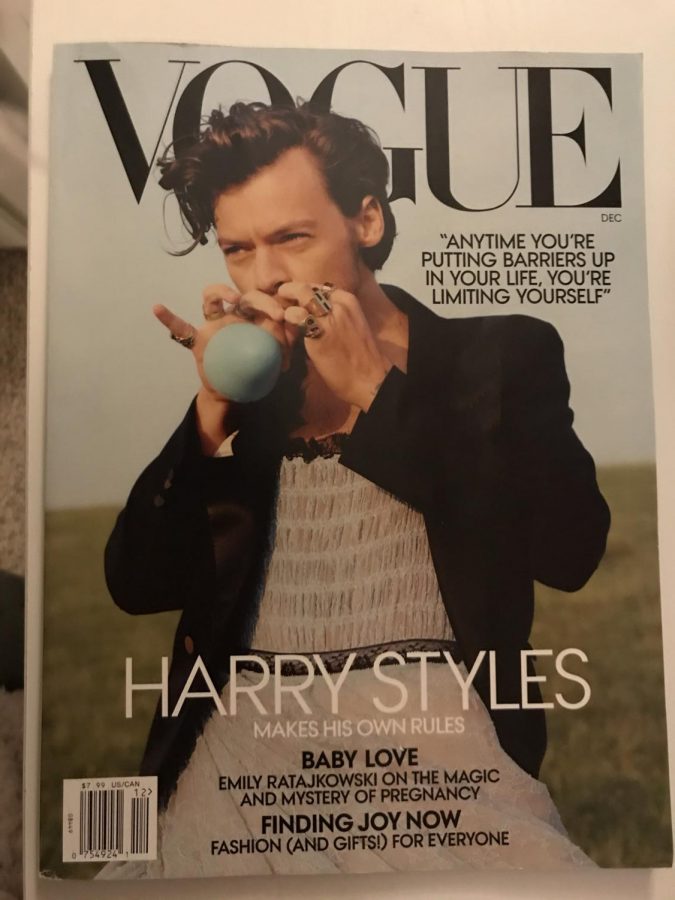Dress to express
Fashion diminishes gender stereotypes
Harry Styles’ Vogue cover premiere shows a sign of the times in the fashion industry regarding stereotypes.
Harry Styles graced the front cover of Vogue in the December 2020 issue, becoming the first man in their 127-year history to stand solo without a woman’s accompaniment. Styles wore a laced, gray, ruffled, floor-length dress with a black blazer and gold rings. His outfit of choice instantly became a controversy and a trending topic of “The Dress” on Twitter.
His loyal fans praised and supported him for breaking gender norms by wearing the dress. Over recent years, Styles’ fashion has grown unique and stands out from most musical artists. He typically wears shimmering blouses, high waisted pants, bold colors, pearls, jewels and occasionally has his nails painted. Those unfamiliar with Styles’ use of clothing as a form of expression quickly criticized him for publicly wearing a dress.
One piece of backlash came from Candace Owens, a widely known conservative political analyst.
“There is no society that can survive without strong men. The East knows this. In the west, the steady feminization of our men at the same time that Marxism is being taught to our children is not a coincidence. It is an outright attack. Bring back manly men,” Owens stated in a quote retweeting Vogue regarding Styles’ dress.
Styles fired back, Tweeting the cover of himself captioning, “Bringing back manly men,” shading Owens while inciting the dress does not define his masculinity.
Her Tweet sparked the conversation of ending gender stereotypes and promoting more androgynous fashion. Whether a man chooses to wear a pink top with puffy sleeves or a camouflage T-shirt does not change their gender or degrade their masculinity.
Clothing does not only appeal to one gender, as it has molded to do so in the past. All clothing has the same purpose, so there is no reason why there should be labels of who should wear what if it is all essentially the same. If a certain style or piece of clothing catches the eye of someone who can confidently flaunt it, there is no need for criticism. Allowing everyone to express themselves with fashion in a way that fulfills them is a positive thing. Granted, not every person wants to break out and wear something untraditional, but the goal is to feel satisfied when choosing a daily outfit, no matter what it is.
Harry Styles isn’t the only celebrity breaking gender norms for fashion. Timothee Chalamet, Billy Porter and Jaden Smith have all been seen wearing sparkles, skirts, sheer and silk.
Styles and Chalamet have a similarity in their tastes as they both go to Gucci, Haider Ackermann, Louis Vuitton and Alessandro Michele for custom made fashion pieces. The goal for designers is to have a fine line between masculinity and femininity because fashion is fluid.
During a red carpet premiere, Chalamet wore a plain black button-down with casual black pants and shoes. What made this look stand out was the accented black vest embedded with jewels and sparkle, plus the golden rings on his hands. This outfit, designed by Louis Vuitton, was so memorable because it had the essence of masculinity and femininity incorporated into it concurrently.
“When you take away ‘There’s only clothes for men and there’s clothes for women,’ once you remove any barriers, obviously you open the arena in which you can play,” Styles said during an interview with Vogue. Both Styles and Chalamet were named influential fashion icons in 2020 by Vogue.
Fashion is supposed to be fun and expressive. Having influential men like Harry Styles or Timothee Chalamet breaking these gender stereotypes in fashion empowers more people who are maybe scared to wear that frilly top or high waisted pants they have always wanted, to go for it. It is becoming more accepted due to celebrities showing their androgyny expression and having their fans follow. Society is slowly growing into a genderless clothing world because clothes do not have a gender. They are just simple pieces of cloth.
Many parents are not dressing their newborns in pink and blue anymore, but in more neutral tones like yellow or green. When babies grow older and dress themselves, they are not inclined to only wearing pink or blue based on their gender. More stores are beginning to reduce the number of labels placed in their clothing sections, implying both males and females can shop anywhere in the store and feel accepted.
Clothing is an aid used to express, not to degrade or label.



